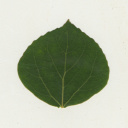Here are two different aspen leaves I collected over the summer. One is a bit smaller (they are at the same scale) but how similar are they otherwise?
 |
 |
What do they look like on the inside? Here are the vein networks for each, shown at the same scale:
 |
 |
The smaller leaf seems to have a higher density of veins than the larger leaf. Why? There are a few possibilities. One is very simple: because the second leaf is smaller. In leaf development, the venation network is laid out early on and fixed for the lifetime of the leaf, whereas leaf size is determined much later. It may be that my second leaf has just not finished expanding, and it has the same fundamental network as the first leaf.
Another explanation is that both leaves are adapted to their respective environments. What I didn’t tell you is that these leaves come from different trees, different clones, different locations – an elevation difference of a few hundred feet and a change from wet forest to rocky talus. Maybe these different leaves function differently – and each, better – in the place they live. In fact, the first leaf has a 15% higher photosynthesis (carbon uptake) rate than the second leaf, but also a 15% lower carbon construction cost. What kind of economic tradeoff is this? Or is this a fluke?
I don’t know which hypothesis (if either) is correct yet. I have another 256 leaves from other aspen trees to also analyze. With the right statistical techniques I should have a confident answer in a few weeks!

Comments
7 responses to “A tale of two aspens”
I certainly appreciate and admire the work you do. Your powers of observation are acute and your writing is great! Thanks for blogging about this essential subject.
Thanks Debbie!
Great work! I am looking forward to reading your results. I find what you have discovered is extremely fascinating and just as important.
Thanks! Stay tuned for a few months from now!
Suggestion: Larger leaf in moister environment may keep it’s stomates open longer allowing more carbon dioxide intake. Smaller leaf in dry environment keeps stomates closed more often so that less water vapor escapes, and less carbon dioxide is taken in per unit of time. ‘Construction’ costs in smaller leaf would less efficient if taken from a time unit point of view, since it takes longer for photosynthesis to be completed in a dry environment.
synthesis to take place in that time unit than the larger leaf.
I find your investigations and experiments about vein networks really interesting. I’m planning to do my term project on this topic. But I want to learn how you are carrying out the measuring the carbon amounts.
Next post I’ll explain!